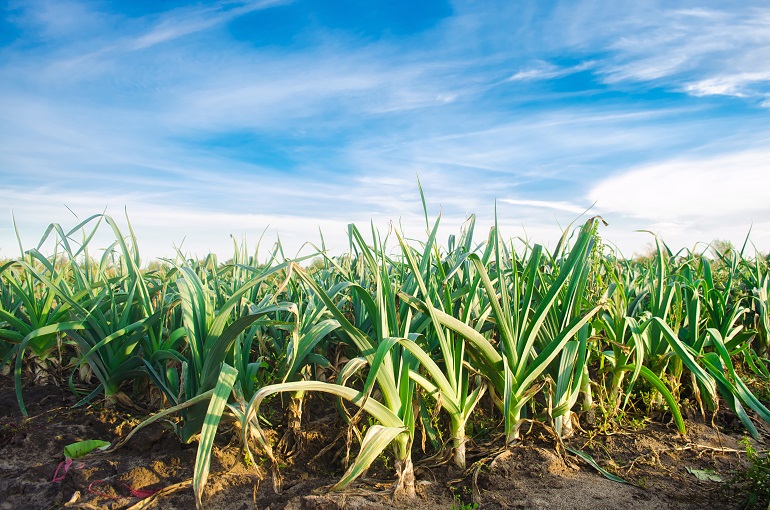Leek Harvest, Yields and Storage

This post is also available in:
This post is also available in:
![]() Español (Spanish)
Español (Spanish) ![]() Français (French)
Français (French) ![]() Deutsch (German)
Deutsch (German) ![]() हिन्दी (Hindi)
हिन्दी (Hindi) ![]() Ελληνικά (Greek)
Ελληνικά (Greek) ![]() Português (Portuguese (Brazil))
Português (Portuguese (Brazil))
How much a leek crop can yield
After years of practice, a good yield for leeks is from 12 to 40 tonnes per hectare or 5-16 tons per acre (on average 15-25 t/ha, or 6-10 t/acre), depending on the plant density. For example, growers have reported yields of 3600 cartons with 12 bunches each from a population of 160,000 plants. Such a population results from distances 60 cm (24 in) x 10 cm (6 in) between rows and plants.
When and how to harvest leeks
The right time to harvest leeks varies depending on the leek variety we cultivate. Leeks are categorized into 4 types depending on their maturity period:
- Summer leeks.
- Autumn leeks
- Autumn-Winter leeks
- Winter leeks
All leek types are planted during spring and harvested at the time their type suggests. For example, summer leeks are planted in early spring, have the shortest life cycle, and are harvested within summer. On the other hand, winter leeks are planted in spring, maybe a bit later than summer-type leeks, and harvested in early winter. There is no strictly defined moment regarding the harvesting time. Broadly speaking, leeks grown from seed are ready for harvesting 6-7 months from sowing in the field. On the other hand, leeks produced by seedlings (transplants) are ready approximately after 3-4 months from transplanting. The goal is to harvest leeks that have formed a white shank with an acceptable commercial size of 15-20cm (6-8 in) and 3-7 cm (1.2-3 in) diameter. To obtain the highest prices possible, the leek shanks should have good quality [optical characteristics, taste, and texture (tender)].
Producers usually harvest leeks consecutively every 3-4 days. Leeks are harvested early in the morning to prevent wilting from intense transpiration. The entire plants are uprooted manually (by hand or with garden forks) or mechanically. In mechanical Harvesting, the machine first cuts the leaves of the plants and then, extracting the leeks from the ground is much easier
How to handle and store leeks
After harvested from the field, the roots of the leeks and part of the leaves are trimmed (10-15 cm or 4-5 inches remain), and then they are transferred to rooms where the excess outer leaf sheaths are removed, the shanks are cleaned, and tied into groups of 4-6. Then, they are either stored or transferred directly to the market. It is essential in order to preserve leeks quality to cool them soon after harvest by using hydrocooling, vacuum cooling or crushed ice. Leeks that are large (15-20 cm (6-8 in) long, 3-5 cm (1.2-2 in) thick-diameter and 200-300 g weight), white, clean, with small or no bulbing at the base and with deep colored leaves with fresh green tops can obtain the highest prices in the market. Leeks can be stored for up to 2-4 months in 0-2 °C (32-35 °F) temperature and 90-95% relative humidity. Poorly stored leeks are expected to lose weight and if this loss reach 15% then moderate wilting will be noted.
References
https://southafrica.co.za/leeks-crop-management.html
https://horticulture.oregonstate.edu/oregon-vegetables/leeks-0
https://www.dpi.nsw.gov.au/agriculture/horticulture/vegetables/commodity-growing-guides/leeks
https://www.agric.wa.gov.au/leeks/growing-leeks-western-australia?page=0%2C4
https://extension.usu.edu/yardandgarden/research/leeks-in-the-garden
https://datcp.wi.gov/Documents/mk_fc_82_web%20pdf%20-%20Adobe%20Acrobat%20Pro.pdf
https://extension.umn.edu/vegetables/growing-leeks#harvest-234413
15 Interesting Facts about Leeks
Leek: Info, Facts, Nutritional Value & Health Benefits
Leek Plant Information and Variety Selection
Commercial Leek Farming – How to Grow Leeks for Profit
Leek Soil Requirements, Soil Preparation, and Planting of Leek
Leek Water Requirements and Irrigation Systems
Leek Fertilization Requirements
Leek Harvest, Yields and Storage








































































